[English] 日本語
 Yorodumi
Yorodumi- PDB-6ccx: NMR data-driven model of GTPase KRas-GMPPNP:Cmpd2 complex tethere... -
+ Open data
Open data
- Basic information
Basic information
| Entry | Database: PDB / ID: 6ccx | ||||||
|---|---|---|---|---|---|---|---|
| Title | NMR data-driven model of GTPase KRas-GMPPNP:Cmpd2 complex tethered to a nanodisc | ||||||
 Components Components |
| ||||||
 Keywords Keywords | MEMBRANE PROTEIN/ONCOPROTEIN / protein-bilayer-compound complex / MEMBRANE PROTEIN-ONCOPROTEIN complex | ||||||
| Function / homology |  Function and homology information Function and homology informationDefective ABCA1 causes TGD / high-density lipoprotein particle receptor binding / peptidyl-methionine modification / HDL clearance / spherical high-density lipoprotein particle / Scavenging by Class B Receptors / negative regulation of response to cytokine stimulus / protein oxidation / regulation of intestinal cholesterol absorption / vitamin transport ...Defective ABCA1 causes TGD / high-density lipoprotein particle receptor binding / peptidyl-methionine modification / HDL clearance / spherical high-density lipoprotein particle / Scavenging by Class B Receptors / negative regulation of response to cytokine stimulus / protein oxidation / regulation of intestinal cholesterol absorption / vitamin transport / blood vessel endothelial cell migration / cholesterol import / negative regulation of heterotypic cell-cell adhesion / ABC transporters in lipid homeostasis / apolipoprotein A-I receptor binding / apolipoprotein receptor binding / high-density lipoprotein particle binding / negative regulation of cell adhesion molecule production / negative regulation of cytokine production involved in immune response / HDL assembly / negative regulation of very-low-density lipoprotein particle remodeling / phosphatidylcholine biosynthetic process / glucocorticoid metabolic process / acylglycerol homeostasis / phosphatidylcholine-sterol O-acyltransferase activator activity / positive regulation of phospholipid efflux / Chylomicron remodeling / cellular response to lipoprotein particle stimulus / Chylomicron assembly / high-density lipoprotein particle clearance / phospholipid efflux / chylomicron / high-density lipoprotein particle remodeling / positive regulation of cholesterol metabolic process / reverse cholesterol transport / lipid storage / phospholipid homeostasis / high-density lipoprotein particle assembly / chemorepellent activity / low-density lipoprotein particle / lipoprotein biosynthetic process / cholesterol transfer activity / cholesterol transport / high-density lipoprotein particle / very-low-density lipoprotein particle / regulation of Cdc42 protein signal transduction / endothelial cell proliferation / HDL remodeling / cholesterol efflux / Scavenging by Class A Receptors / triglyceride homeostasis / adrenal gland development / response to mineralocorticoid / GMP binding / negative regulation of interleukin-1 beta production / negative chemotaxis / forebrain astrocyte development / cholesterol binding / LRR domain binding / regulation of synaptic transmission, GABAergic / negative regulation of epithelial cell differentiation / cholesterol biosynthetic process / response to isolation stress / amyloid-beta formation / positive regulation of Rho protein signal transduction / response to gravity / epithelial tube branching involved in lung morphogenesis / type I pneumocyte differentiation / Rac protein signal transduction / positive regulation of Rac protein signal transduction / Signaling by RAS GAP mutants / Signaling by RAS GTPase mutants / Activation of RAS in B cells / myoblast proliferation / skeletal muscle cell differentiation / RAS signaling downstream of NF1 loss-of-function variants / RUNX3 regulates p14-ARF / positive regulation of glial cell proliferation / endocytic vesicle / SOS-mediated signalling / Activated NTRK3 signals through RAS / Activated NTRK2 signals through RAS / positive regulation of cholesterol efflux / SHC1 events in ERBB4 signaling / negative regulation of tumor necrosis factor-mediated signaling pathway / cardiac muscle cell proliferation / Signalling to RAS / Activated NTRK2 signals through FRS2 and FRS3 / SHC-related events triggered by IGF1R / Scavenging of heme from plasma / Estrogen-stimulated signaling through PRKCZ / glial cell proliferation / SHC-mediated cascade:FGFR3 / MET activates RAS signaling / SHC-mediated cascade:FGFR2 / cholesterol metabolic process / PTK6 Regulates RHO GTPases, RAS GTPase and MAP kinases / Signaling by PDGFRA transmembrane, juxtamembrane and kinase domain mutants / Signaling by PDGFRA extracellular domain mutants / SHC-mediated cascade:FGFR4 Similarity search - Function | ||||||
| Biological species |  Homo sapiens (human) Homo sapiens (human) | ||||||
| Method | SOLUTION NMR / simulated annealing | ||||||
 Authors Authors | Fang, Z. / Marshall, C.B. / Nishikawa, T. / Gossert, A.D. / Jansen, J.M. / Jahnke, W. / Ikura, M. | ||||||
 Citation Citation |  Journal: Cell Chem Biol / Year: 2018 Journal: Cell Chem Biol / Year: 2018Title: Inhibition of K-RAS4B by a Unique Mechanism of Action: Stabilizing Membrane-Dependent Occlusion of the Effector-Binding Site. Authors: Fang, Z. / Marshall, C.B. / Nishikawa, T. / Gossert, A.D. / Jansen, J.M. / Jahnke, W. / Ikura, M. | ||||||
| History |
|
- Structure visualization
Structure visualization
| Structure viewer | Molecule:  Molmil Molmil Jmol/JSmol Jmol/JSmol |
|---|
- Downloads & links
Downloads & links
- Download
Download
| PDBx/mmCIF format |  6ccx.cif.gz 6ccx.cif.gz | 1.8 MB | Display |  PDBx/mmCIF format PDBx/mmCIF format |
|---|---|---|---|---|
| PDB format |  pdb6ccx.ent.gz pdb6ccx.ent.gz | 1.6 MB | Display |  PDB format PDB format |
| PDBx/mmJSON format |  6ccx.json.gz 6ccx.json.gz | Tree view |  PDBx/mmJSON format PDBx/mmJSON format | |
| Others |  Other downloads Other downloads |
-Validation report
| Summary document |  6ccx_validation.pdf.gz 6ccx_validation.pdf.gz | 4.5 MB | Display |  wwPDB validaton report wwPDB validaton report |
|---|---|---|---|---|
| Full document |  6ccx_full_validation.pdf.gz 6ccx_full_validation.pdf.gz | 32.5 MB | Display | |
| Data in XML |  6ccx_validation.xml.gz 6ccx_validation.xml.gz | 2.5 MB | Display | |
| Data in CIF |  6ccx_validation.cif.gz 6ccx_validation.cif.gz | 2.8 MB | Display | |
| Arichive directory |  https://data.pdbj.org/pub/pdb/validation_reports/cc/6ccx https://data.pdbj.org/pub/pdb/validation_reports/cc/6ccx ftp://data.pdbj.org/pub/pdb/validation_reports/cc/6ccx ftp://data.pdbj.org/pub/pdb/validation_reports/cc/6ccx | HTTPS FTP |
-Related structure data
| Related structure data |  6cc9C  6cchC C: citing same article ( |
|---|---|
| Similar structure data | |
| Other databases |
|
- Links
Links
- Assembly
Assembly
| Deposited unit | 
| |||||||||
|---|---|---|---|---|---|---|---|---|---|---|
| 1 |
| |||||||||
| NMR ensembles |
|
- Components
Components
-Protein , 2 types, 3 molecules ACB
| #1: Protein | Mass: 23234.295 Da / Num. of mol.: 2 / Fragment: UNP residues 68-265 Source method: isolated from a genetically manipulated source Source: (gene. exp.)  Homo sapiens (human) / Gene: APOA1 / Production host: Homo sapiens (human) / Gene: APOA1 / Production host:  #2: Protein | | Mass: 21302.330 Da / Num. of mol.: 1 / Mutation: G12V Source method: isolated from a genetically manipulated source Source: (gene. exp.)  Homo sapiens (human) / Gene: KRAS, KRAS2, RASK2 / Production host: Homo sapiens (human) / Gene: KRAS, KRAS2, RASK2 / Production host:  |
|---|
-Non-polymers , 5 types, 83 molecules 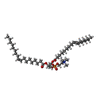








| #3: Chemical | ChemComp-PCW / #4: Chemical | ChemComp-17F / #5: Chemical | ChemComp-GNP / | #6: Chemical | ChemComp-MG / | #7: Chemical | ChemComp-EWS / ( | |
|---|
-Experimental details
-Experiment
| Experiment | Method: SOLUTION NMR | ||||||||||||||||||||||||||||||
|---|---|---|---|---|---|---|---|---|---|---|---|---|---|---|---|---|---|---|---|---|---|---|---|---|---|---|---|---|---|---|---|
| NMR experiment |
| ||||||||||||||||||||||||||||||
| NMR details | Text: HADDOCK modelling consists of (I) rigid-body docking, (II) a semi-flexible refinement stage, and (III) final refinement in explicit solvent (final gentle water). The starting structure is 2MSE. ...Text: HADDOCK modelling consists of (I) rigid-body docking, (II) a semi-flexible refinement stage, and (III) final refinement in explicit solvent (final gentle water). The starting structure is 2MSE. Distance restraints are based on PRE, NOE and CSP. |
- Sample preparation
Sample preparation
| Details |
| ||||||||||||||||||||||||||||||||||||||||||||||||||||||||||||||||
|---|---|---|---|---|---|---|---|---|---|---|---|---|---|---|---|---|---|---|---|---|---|---|---|---|---|---|---|---|---|---|---|---|---|---|---|---|---|---|---|---|---|---|---|---|---|---|---|---|---|---|---|---|---|---|---|---|---|---|---|---|---|---|---|---|---|
| Sample |
|
 Movie
Movie Controller
Controller



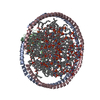

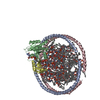




 PDBj
PDBj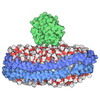





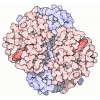








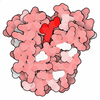



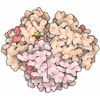







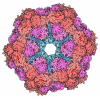




 gel filtration
gel filtration



